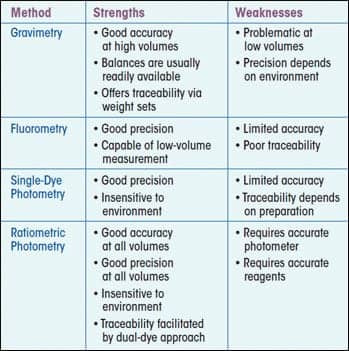 |
Like laboratory safety, quality regulation, and quality control, sample handling—particularly, liquid handling—deserves significantly more importance from laboratorians. Every scientist in every field works with instruments, does experiments, or uses assays; and requires reagents that need to be mixed, added, quantitated, and/or detected. For that purpose, the precise and accurate measurement of reagents—mostly in liquid form—is essential.
This process is obviously standardized by repeat assays, multiple operators, multiple runs, and the use of different instruments. To that end, the first line of defense would be a handheld pipette or a liquid dispenser. You might consider the presence of liquid-handling instruments so commonplace that you take it for granted. But ongoing improvements in liquid-handling instruments are allowing laboratory work to be much more accurate, precise, and reproducible.
Pipettors—The Good and the Bad
Certain alarming information regarding the handling of pipettes has recently emerged that has encouraged companies to produce ergonomically friendly pipettes.1
- Pipetting more than 90 minutes per day or 300 hours per year exposes a scientist/technician to repetitive strain injury.
- Lab workers develop work-related upper limb disorder twice as often as general employees.
- More than 44% of lab workers have or have suffered from pipetting-related disorders.
- Pressing the plunger button and ejecting tips with a standard mechanical pipette together requires a force of up to 7 kg, which is equivalent to the force required to lift 7 L of milk.
Based on these issues, most companies are now manufacturing pipettes that are light, durable, ergonomically safe, easy to use, readily decontaminated, and easily calibrated. Below are some companies that offer ergonomic pipette product lines.
Pipettor Options
Most mechanical pipettors, besides being ergonomically challenging, also propose multiple challenges:
- risk of injury via stress (ergonomics);
- user risk via sample leak/contamination; and
- sample risk via environmental factors (cross-contamination).
The mLINE and multichannel pipettors (0.1 µL to 10 mL range) from Biohit Inc, Neptune, NJ, present an elegant solution to these issues. According to the company, the volume lock in the pipettes prevents accidental volume change, and the patented “Optiload” tip-loading mechanism in these pipettes allows for easy tip ejection.
Biohit Inc (a subsidiary of Biohit Oyj, a Finnish company that develops, manufactures, and markets liquid-handling and diagnostic products for research, health care, and industry applications) also points to its best manufacturing practices, which aim to use only recyclable material. For example, the company’s mLINE and Proline Plus mechanical pipettes are more than 90% recyclable, and the company uses no-Cd environmental-friendly batteries in its electronic handling devices.
New Jersey-based Globe Scientific Inc, which has produced labware, glassware, and liquid-handling and benchtop equipment for more than 3 decades, offers the Diamond™ and Diamond Pro™ single-channel fixed, adjustable-volume, and multichannel adjustable-volume pipette lines. According to the company, Diamond pipettors are a cost-effective alternative to high-priced name-brand standard pipettes. With an autoclavable lower assembly, high accuracy and precision, along with easy identification, reverse-pipetting options, and ergonomic shape, these pipettors are attractive options in this market.
According to Milton Diamond, president of Globe Scientific, “Our products are produced using automated processes to keep costs down. We also produce these pipettes from a special blend of polyethylene to make them nonslippery when used with rubber gloves.”
Globe Scientific also has an effective, economic, and accurate alternative for use in fixed-volume dispensation: its Diamond Jr. pipettors, which fit easily in lab coat pockets, are autoclavable, and are ideal in diagnostics where an economical pipettor is necessary. “Due to the current economic times, there is a great need for high-quality liquid-handling products that help to improve efficiency while providing cost savings to the laboratories,” Diamond says. “We keep cost and convenience in mind while developing every new product.”
In late 2009, Thermo Fisher Scientific Inc, Middletown, Va, announced its new Thermo Fisher Finnpipette F2 pipettor, which has a “soft-touch” tip ejector for increased ergonomics. According to the company, the pipette has a patented gearing system that helps significantly reduce repetitive strain injury by decreasing the tip-ejection force.
The pipettor is softly contoured, easy to use, and, with the added benefits of volume precision (within two decimal points) and prevention of volume drift during pipetting, it is suitable for all routine laboratory applications. It has a variable and fixed single-channel volume range (0.2 µL to 10 mL), and it is versatile, fully autoclavable (which helps prevent cross-contamination), and color-coded for easy pairing with the corresponding Thermo Scientific Finntip (pipette tip).
According to Diamond, “In 2010, we (Globe Scientific) will be launching a new line of single-channel and multichannel pipettors that are ergonomically designed, fully autoclavable, UV resistant, and lightweight. [They are] designed for high accuracy, simple to use, and can be easily serviced by the user by following simple instructions.” He adds that the pipettor should eliminate the need to outsource calibration or cleaning, and it is designed for both left-handed and right-handed users.
Most laboratorians are also familiar with products such as Rainin’s “hand-friendly” pipettes for accuracy and repeatability along with its patented LTS Lite-Touch System that yields little fatigue or injuries to the user, and, hence, low numbers of operator errors. Rainin (Mettler Toledo) has been in the liquid handling business for decades and has acquired a global presence in the field. So has Gilson Inc, Middleton, Wis, a company that, since 1972, has provided a philosophy of quality, robustness, and precision with its Pipetman® brand.
Pipette Tips
In addition to instruments for liquid handling, a key consumable in laboratories are pipette tips. The days of reusing tips are long gone. Easy-to-use and easy-to-discard plastic tips, transfer pipettes, and safety tips are products with increasing innovation and competition.
Biohit recently announced its new SafetySpace Filter Tips, a safer method for transferring samples without the chance of sample touching the filter, regardless of what kind of liquid is being handled. According to the company, its presterilized SafetySpace Filter Tips (available in the 10- to 1,200-µL range) are certified DNase, RNase, and endotoxin-free, and are compatible with all Biohit pipettors as well as most other pipette brands. Additionally, Biohit Tips are manufactured according to strict quality and environmental standards, using eco-friendly PP.
Gilson’s Pipetman® Filter Tips, along with its Pre-Sterilized Tower Racks, come as standard options with its Pipetman systems.
Every pipette company offers its own set of consumables that attract return customers. Companies such as Globe Scientific also offer liquid-handling disposables including plastic transfer pipettes made from low-density polyethylene (LDPE). Due to LDPE’s disposable properties, these pipettes significantly minimize cross contamination or user contamination. Globe Scientific offers these transfer pipettes in multiple volume ranges for use in blood bank collection devices, standard lab procedures, and even diagnostic kits and small-volume transfers.
Volume Dispensation: Quality Control/Validation Assays
While most pipette companies focus on easy liquid handling, accuracy, and precision, a big factor in a “good” pipette is the precision and how that can be verified. The trend toward lower-volume liquid handling, particularly to support molecular diagnostics, is leading to a need for tools to measure these volumes. Larger companies such as Rainin (Mettler Toledo) as well as Gilson have their own service/calibration centers where their pipettes can be returned for calibration, measurement of accuracy and precision, as well as decontamination. However, newer companies are now offering novel methods for the same that could be carried out in labs without sending out the pipettes.
Maine-based ARTEL is one such company, providing services that answer critical questions in liquid handling—ie, accuracy and precision of liquid-handling equipment—to ensure superior assay results. ARTEL’s core products allow for:
- pipette calibration in minutes;
- determination of exact volumes dispensed by automated liquid handlers;
- standardized lab pipetting and certification; and
- management of performance and maintenance of pipettes.
George Rodrigues, PhD, senior scientific manager, ARTEL, describes its multichannel verification system (MVS) as an easy-to-use universal system “that verifies volume transfer performance of automated liquid-handling systems and multichannel pipettes.”
Key features include:
- accuracy/precision of an eight-channel automated liquid handler verified in 5 minutes;
- accuracy/precision information for each tip within minutes;
- a volume/range measurement range of 0.01 to 350 µL;
- performance and volume statistics measured on a tip-by-tip and a well-by-well basis;
- results that are standardized and traceable to the National Institute of Standards and Technology (NIST);
- compatibility with 96-well and 384-well microtiter plates;
- applicability to automated liquid handlers with 1 to 384 dispensing tips, and to handheld multichannel pipettes;
- ease of use; and
- better reliability than any other volume-verification method for multichannel liquid-handling instrumentation.
ARTEL also provides a pipette calibration system (PCS) for calibrating and verifying volumes dispensed from single-channel pipettes. A single handheld pipette can be calibrated in about 3 minutes, and the system can track the inventory; store calibration data; print bar code labels and calibration stickers; and provide reports, pipette performance trends, and a training tool.
 |
“Operating new technology without an objective measurement tool is essentially like driving a car without a dashboard,” says Kirby Pilcher, president of ARTEL. “Our recent MVS developments are aimed at giving laboratories more powerful information about the performance of their instrumentation. By more fully understanding their automated liquid handlers, laboratories can take steps to measurably improve quality, productivity, and data integrity.”
Rodrigues adds, “ARTEL will soon launch new features of the ARTEL MVS® that enhance data comparability measurement, increase the volume verification speed, and reduce the overall variability of lab processes.”
Both MVS and PCS are based on ratiometric photometry. Rodrigues elaborates that the techniques, when compared to other technologies, give “more channel-specific, more convenient (faster and standardized), and better data (NIST-traceable).”
A comparison with other techniques is tabulated in the table at right:
The Future
Every liquid-handling company strives for better performance, precision, and trusted results from its products. In terms of new products, Globe Scientific’s new line of pipettes have a special PFTE seal for precise air tightness for long-term use. ARTEL expects to launch variations to enhance its MVS validation system while Thermo Fisher has just launched a new FinnPipette system.
While the market is filled with multiple players with very precise results, the fact that most laboratories depend on their instruments’ precision, validation, and accuracy suggests that these liquid-handling companies will only continue to improve the quality of their products in the future.
Madhushree Ghosh, PhD, is a San Diego-based science and health writer.
Reference
- Björkstén MG, Almby B, Jansson ES. Hand and shoulder ailments among laboratory technicians using modern plunger-operated pipettes. Applied Ergonomics. 1994;25(2):88-94.



